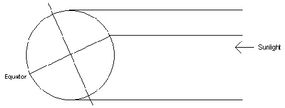
It turns out that the elliptical orbit of the Earth has little effect on the seasons. Instead, it is the 23.45-degree tilt of the planet's rotational axis that causes us to have winter and summer.
Have you ever paused to wonder, "What causes seasons?" As you feel the cool breeze of fall or the warmth of summer, it might seem like a simple question, but there's an interesting bit of science behind it. Let's unravel the intricate interplay of Earth's tilt and orbit and shed light on the reasons we experience seasons.
Advertisement
